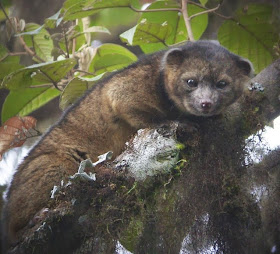 |
| Bassaricyon neblina sp. nov. (Photo by Mark Gurney/Reuters/Smithsonian Institution, via AH News) |
Taxonomic revision of the olingos (Bassaricyon), with description of a new species, the Olinguito
Kristofer M. Helgen1,†, C. Miguel Pinto2,3,4,5,‡, Roland Kays6,7,8,§,
Lauren E. Helgen1,|, Mirian T. N. Tsuchiya1,9,10,¶, Aleta Quinn1,11,#,
Don E. Wilson1,††, Jesús E. Maldonado1,10,‡‡
Abstract
We present the first comprehensive taxonomic revision and review the biology of the olingos, the endemic Neotropical procyonid genus Bassaricyon, based on most specimens available in museums, and with data derived from anatomy, morphometrics, mitochondrial and nuclear DNA, field observations, and geographic range modeling. Species of Bassaricyon are primarily forest-living, arboreal, nocturnal, frugivorous, and solitary, and have one young at a time. We demonstrate that four olingo species can be recognized, including a Central American species (B. gabbii), lowland species with eastern, cis-Andean (B. alleni) and western, trans- Andean (B. medius) distributions, and a species endemic to cloud forests in the Andes. The oldest evolutionary divergence in the genus is between this last species, endemic to the Andes of Colombia and Ecuador, and all other species, which occur in lower elevation habitats. Surprisingly, this Andean endemic species, which we call the Olinguito, has never been previously described; it represents a new species in the order Carnivora and is the smallest living member of the family Procyonidae. We report on the biology of this new species based on information from museum specimens, niche modeling, and fieldwork in western Ecuador, and describe four Olinguito subspecies based on morphological distinctions across different regions of the Northern Andes.
Read the full article: Click HERE.

No hay comentarios:
Publicar un comentario